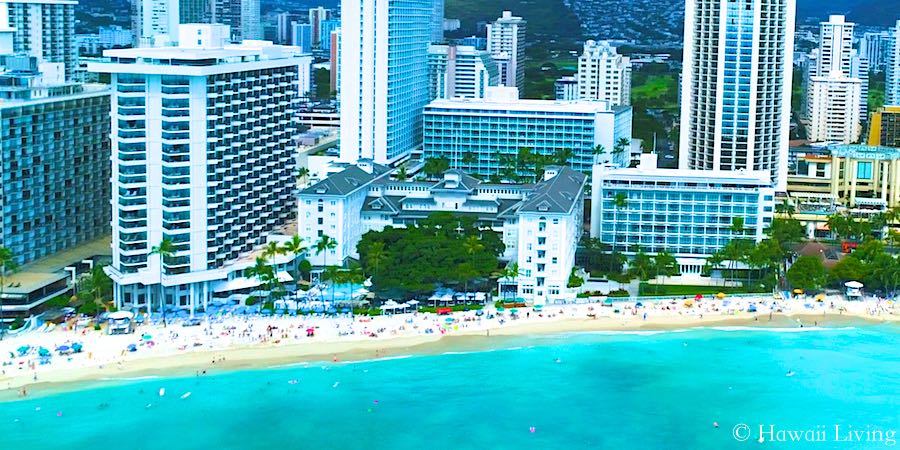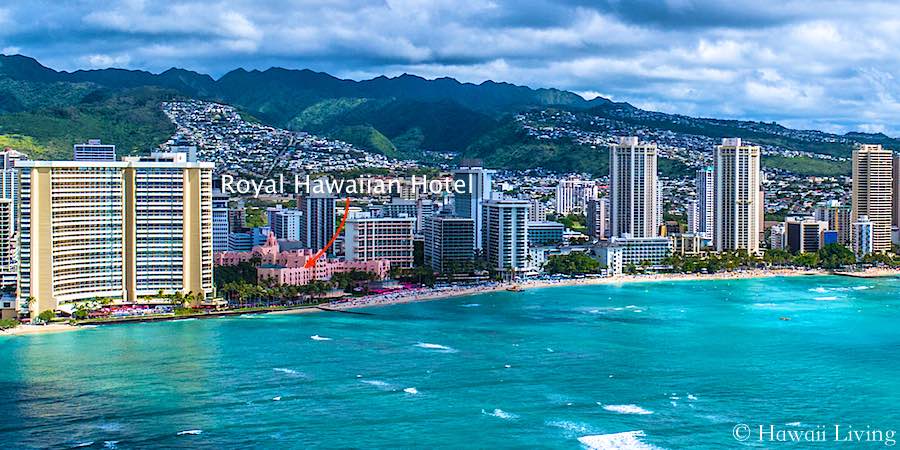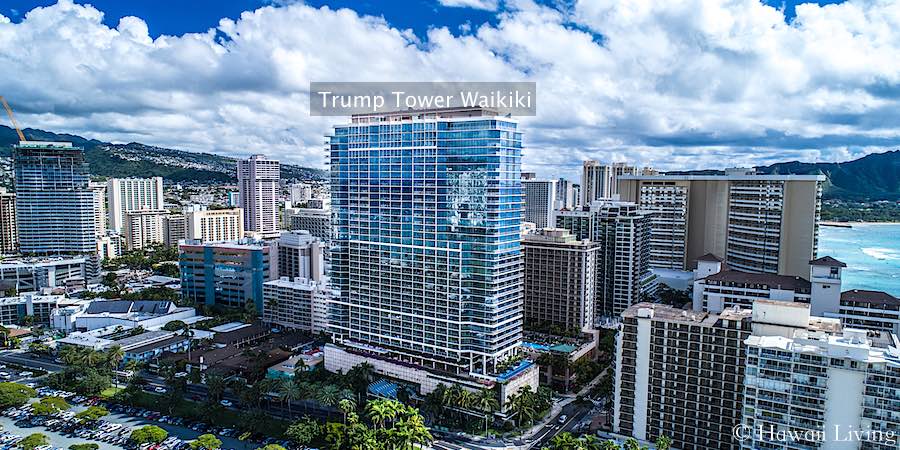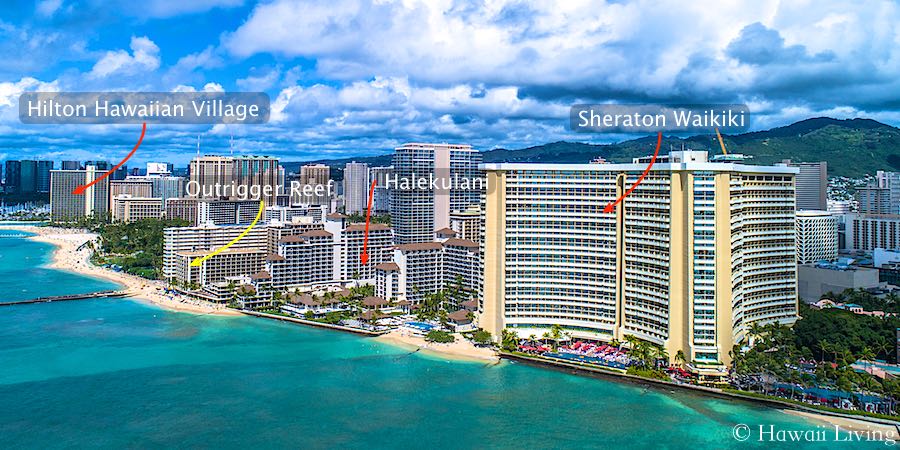Get ready for your world to be turned upside down! For years, the Moana Hotel (now Moana Surfrider) has billed itself as Waikiki’s very first 1st hotel. A title they’re justly proud of. Except they weren’t the 1st at all.
It was no doubt the first substantial lodging in the district, with modern luxury offerings like electric elevators and a spa, but there’s at least one place that was here before the Moana’s 1901 opening. You won’t believe what went on there, either.
Long gone, this was the Sans Souci Hotel, which stood beside the beach that still goes by that same name. A man named George Herbert bought the beachside land around 1884, with plans for a small resort to capitalize on the even then emerging tourism business.
The year before King Kalakaua had turned the area into a true social and recreational center with his racetrack in Kapiolani Park, frequent luaus at his residence here and creation of an actual road connecting the place to Honolulu, so the trip was now an easier and much smoother experience.
Not much is known about George Herbert’s place, other than that he eventually got his dream either partially or fully built before leasing it to a Greek immigrant named George Lycurgus.
Lycurgus gave the resort its name, Sans Souci (‘Without Cares’), and made it an internationally known place to stay in the days when the visiting well-to-do would be in residence for months at a time. It is still remembered as the place Robert Louis Stevenson stayed in 1893 on his 2nd trip to Hawaii.
WAIKIKI’S 1st HOTEL – A LESSON IN MIXING BUSINESS WITH POLITICS
Those familiar with Hawaii history will recognize 1893 as also the year of the overthrow of Queen Liliuokalani, who Lycurgus supported even afterward. So much so that the Sans Souci hosted secret meetings of Royalists who planned a rebellion against the Provisional Government who now ruled. It is even believed that guns supplied to what became the Wilcox Rebellion were landed at the hotel’s beach, and were possibly even hidden briefly by Lycurgus.
The rebellion was put down quickly and Lycurgus was put in jail. Once released he immediately left for the Big Island, where he ran another famous concern, Volcano House. Sans Souci Hotel, meanwhile, went out of business soon after his exit, leaving Waikiki without an inn for the next 5 years.
With growing demand, it was clear that condition wouldn’t last too long. Just how strong the demand was could be seen in the building of the 4 story, 75-room structure that proclaimed Waikiki was open for business. The Moana Hotel admitted its first guests in 1901, luxury lodging in a place that had beautiful ocean and beaches, but also pure wetlands not too far from its front steps.

That didn’t hurt business, however, due to the tropical romance of Hawaii already exerting its pull in this time before radio and television. The Moana’s establishment marked the beginning of Waikiki tourism, an economic powerhouse that drives much of Hawaii’s bottom line today.
Not an immediate success, the 1st owner sold it in 1903 after profits eluded him. The new ownership saw much better returns, even adding 2 more floors and the wings on either side in 1918. While the growing profits were due to an equal surge in arrivals, Waikiki’s geography also helped Moana corner the market.
A little down the beach to the east, the Honolulu Seaside Hotel welcomed guests beginning in 1906. This was a smaller structure and lacked the luxuries of the Moana. Not much is known about the Seaside partially due to its short lifespan of 19 years. In fact it would become most famous for what replaced it, as we’ll see.
In these years the surrounding wetlands made it very difficult for competition to come in, with little solid property to build on that wasn’t already owned by wealthy families who weren’t selling then. That advantage wouldn’t last forever. In fact, very soon it would completely evaporate.
That evaporation came in the form of the Ala Wai Canal, finished in 1928, which turned the swampland into solid real estate. It’s not as well known that the western end of Waikiki benefited as much a the eastern side. The present site of the Hilton Hawaiian Village and nearby areas, which made up what’s known as Kalia, were also transformed then.
Records show that 2 small lodgings were operating here in the early 1920’s, Cressaty’s Court and Hummel’s Court. Beyond their existence, little else is recorded. Both were purchased by an investment company, who replaced them with the Niumalu Hotel in 1928. The Hawaiian style of this hotel, inside and out, was unique in a time when Western styles dominated, making it one that is fondly looked back on by many.
Another beneficiary was the Territorial Hotel Company who now owned both the Moana and the Honolulu Seaside Hotels. The new, expanded Waikiki, and the eradication of the mosquitoes that plagued the swamp areas, made them eager to capitalize on the new possibilities of growing their business further. That meant building a more attractive and upscale property. The Seaside’s days were numbered.
THE PINK PALACE MAKES ITS DEBUT
In 1925 the Honolulu Seaside Hotel was demolished and construction of the now iconic pink Royal Hawaiian Hotel began. On February 1, 1927 the grand opening gala was held to celebrate completion and the arrival of a world-class hotel. If Diamond Head is the unmistakable shorthand for ‘Waikiki’ from the natural world, than the Royal Hawaiian holds the same status in the man-made. A standing it has held since that day in 1927 and will do so as long as it stands.

Despite the Ala Wai Canal’s sweeping change of the land, things remained generally quiet for the next 2 decades on the construction front. Coming by boat was the only option still and cost a lot, keeping the tourist numbers fairly static. Then, as well all know, the closing days of 1941 slammed the brakes on completely.
World War II would see Waikiki Beach strewn with barbed wire in case of invasion and the Royal Hawaiian turned into a serviceman’s recreational facility. Despite the hive of activity on Oahu during those years, tourism was understandably at a standstill. Even with the end of conflict in 1945, it would take a few years for things to get rolling again. In fact, a new decade would have to dawn before they did.
WAIKIKI HOTELS – THE POST WAR BOOM BEGINS
The 1950s were the take-off point when visitor counts began to hit new highs each year at levels never experienced before. Airlines now had planes that could make the trip from the Mainland, and soon everywhere else, with a sizable number of tourists on-board. In addition, the Islands had a new level of prominence in the US due to its important role, and resulting exposure to thousands who were stationed or passed through here, during WWII and then the ever nearing prospect of Statehood.
Something bigger was needed to house this new, unprecedented explosion of visitors. 1951 saw the Edgewater Hotel’s 100 rooms first occupied, the first property of the Kelley family who would go on to expand and create the Outrigger Hotel chain that has been a major player in Hawaii for decades now.
The Kelleys’ decision to feature the first large swimming pool in Waikiki at the Edgewater was initially seen as a bad investment, since the ocean was just a block away. The Edgewater’s 6 floors weren’t the wave of the future, however.
That wave landed in 1955 with, for the first time, high-rises. In that one year alone, 4 new hotels were opened in Waikiki. 3 of them were prime examples of the new multi-story tower blueprint – The Reef (today know as Outrigger Reef), the Princess Kaiulani and the Waikiki Biltmore, all of them rising to either 10 or 11 floors. The 4th opening of 1955 brought something very, very different to the coastline.
The Niumalu Hotel and several more acres next to it were bought up by Henry Kaiser the year previously and work commenced immediately. After leveling the Niumalu, the unveiling of the operational, but still-in-progress, Hawaiian Village Hotel came in September, 1955. On that day visitors could stay in one of the cottages on the grounds, dive into any of 3 swimming pools and enjoy a dinner and a show in the Tapa Room.
Two years later the Ocean (now Ali’i) Tower was up and running, along with a geodesic dome that held shows by popular acts, including both Hawaiian and worldwide entertainment legends. The plan, as the word ‘Village’ implied, was for a complete experience for guests, including restaurants, shops, nightlife and entertainment plus beach and ocean alongside. Visitors need never leave the resort.
While the 1950s were a time of acceleration in the build-up of Waikiki, much of the area was still low-rise and even undeveloped. The high-rise momentum was rolling, but hadn’t reached full speed yet. The Waikikian Hotel, the quintessential example of mid-century tiki design, was one example of this dichotomy when it joined the landscape in 1956 on Ala Moana Blvd, next to the Hawaiian Village.
Its Polynesian A-Frame lobby building stood out starkly for the first few years it existed, the main lodging being in 2 dual-level buildings behind. Coming into Waikiki across the Ala Wai your gaze went right to it, with little nearby to compete for your attention. In 10 years, though, that view would change dramatically, soon hiding the Waikikian in a forest of towers, like a child in a crowd of NBA players.
1960’s & 70’s – WAIKIKI GOES FULLY URBAN
The joke about the Hawaii State Bird being the construction crane was first told in the 1960’s, mostly associated with the condo buildings that started to sprout then. It’s equally true that those cranes were busy putting up hotels, too.
Like the Hawaiian Village, another project would create something unseen before in Hawaii, let alone Waikiki, and it would do so on the real estate right next door. The Ilikai, with its 26 floors and 3 wings that made a gigantic ‘Y’ towered over everything in sight when it opened in 1964. It was bigger than anything else in the Islands and the first luxury high-rise hotel in Hawaii. From that day it was one of the top hotels in Waikiki for over a decade, aided by its prominence in the Hawaii Five-0 opening credits.
The now Hilton Hawaiian Village wasn’t idle either, proudly unveiling the Rainbow Tower in 1968, the bungalows fully giving way to the beginning of the soaring complex we have now. It’s easy to see why they did. Visitor arrivals hit 1 Million in that very same year, filling the approximately 15,000 hotel rooms that the Visitors Bureau boasted of within Waikiki by 1969. Many more were still to come.
Over 1,900 of those rooms came in the Sheraton Waikiki alone, a marvel of modern design that occupied the neighboring lot to the Royal Hawaiian beginning in 1971. The mark of Waikiki as a Mature market was reached as the 1st wave of large properties came down to make room for even larger ones. The Waikiki Biltmore was demolished in 1974, replaced by the Hyatt Regency’s two 40-story towers that added 1,234 more rooms to the local count two years later.
THE 80’s & 90’s – SLOWING ASCENT
The following decades of the 1980s and 90’s saw more new building go up, but it was already slowing in the former time, with most of the lots now occupied. The Waikiki hotels that did come from this era were not showpieces, like the Sheraton or the Hyatt of the previous decade.
The Japanese investment boom of the time saw some leisure properties bought up, but the development side driven by it was mostly outside of Waikiki. Any chance that they’d get around to buying up more of the world-renowned resort district was put to rest once the Japan economy crashed in the 90s, which drove Hawaii into recession as well.
Still, one obvious alteration that came out of the surge in interest from the Japanese was the new focus on serving that segment, from Japanese-speaking staff to Japanese language signs, menus & brochures being as prominent as their English counterparts to new services that catered to their interests & expectations, hotels went all out to attract and keep them. The fact that they spent more per day than any other tourist segment made them prize guests, a status they still have today.
These years also saw a consolidation, as most of the independent hotels came under chain ownership. Even local Outrigger, who had 4 properties in 1969, could claim 18 in their portfolio by 1986, some their own creations, but a good percentage purchased as well. There are now very few places on the main strips whose name isn’t preceded by a chain’s title. Things had changed very quickly in Waikiki, pushed inevitably forward by the ongoing gold rush that was Hawaii’s post-war tourism trade.
THE MILLENNIM AND BEYOND – WHAT IS HAPPENING NOW
The recent decades have seen visitor arrivals, with the exception of the dip following the 2008 economic implosion, continue to grow, but not at the rate of the decades before. Part of the reason is that capacity has more or less been reached, with hotels in Waikiki being booked up, or near it, year round.
There is a shift now toward targeting the more affluent market, most easily observed in the main drag of Kalakaua Ave turning into a row of high-end designer stores lining both sides of the street. The change in the hotel properties has had a slower road to follow here, due to the perennial problem of the lack of available space to build upon. Even so, the entrances of Trump Waikiki and the Ritz-Carlton Residences are solid indicators of which way the wind is blowing.

In addition, there are plans by hotel owner Kyo-Ya to replace the Surfrider with a 26 story tower aimed at a clientele with deep pockets and expensive tastes. The Princess Kaiulani is also intended for an extensive facelift that may include new building there as well.
However, there has been strong community resistance to these proposals, especially the Surfrider project, due to the builders’ request for a height limit exception and fears that the project will accelerate beach erosion. Currently the future of Kyo-Ya’s vision is still unsure due to the public outcry.
Another trend of recent years is an effort to appeal to the traveler who wants to stay in more than just the typical bed-tv-bathroom format, but not at a luxury price tag. Standard properties across the area have transformed into boutique hotels to get those more discerning travelers.
The Coral Reef recently re-opened as the Laylow Hotel, with Atomic Age type furnishings and décor. The Aqua Palms, once the Waikiki Parkside, is now outfitted in hipster chairs, funky artwork hanging and themed rooms like the Musician Suite that has a huge painting of John Lennon on the wall and retro patterned fabrics everywhere. Just two of a series of places that have undergone this metamorphosis.
The final change of the last 10 years or so may be the biggest and that is the condotel system that’s become widespread. The chance to ‘own’ a hotel room for your own enjoyment and/or profit is a viable option in Waikiki real estate today. Most are in existing hotels that went through this process, others, like the Trump, were built with primarily that model from the beginning.
Although mortgages are more difficult to arrange for them, the condotel listings don’t seem to have much problem selling so far. It’s still relatively early, as this has only emerged fully after the Millennium, so there may be issues down the line with this form of property ownership. So far, most are happy with it.
WAIKIKI HOTELS – A SURE BET
The twists and turns of Waikiki’s tourism industry has taken many turns, but always changing to meet demand as well as satisfy new tastes. From the pre-WWII long-term visitors who came on cruise ships to the jet age that rocketed arrivals upward, including a new middle-class market, to the current move to serve more upscale travelers and the experience-centric visitor – Waikiki’s hotels have pivoted to satisfy their wants and needs.
So far that approach has been an unquestioned success. A smart bet today would be that it will remain one as long as Hawaii can keep its enduring romantic image, raising the heart rate of peoples from every corner of the world. Just as it has for so many years before.

Quality Inn Hotel Waikiki (Napualani) in 1985, what is it called now?
What was the name of the 2 story hotel w/kidney shaped pool & the best eggs benedict in town?
Aloha – I’m taking a long shot to answer a nagging question but here goes.
About 1975 I made my first of many trips to Hawaii and spent many a nice evening in a bar in what’s now the Outrigger Reef. The bar was oceanside on the opposite side of the beach access from The Shorebird. It had so much character that you expected John Wayne or Bogart to come stumbling in. It went through a few incarnations since then; an upscale restaurant was the first. I cannot think of the name of that bar, can you?
Is it possible you’re talking about Davy Jones Locker? It had a glass wall attached to the swimming pool! You never knew what you might see. From yellow clouds in the water to wardrobe malfunctions as swimmers dove into the water!
How is it that you completely skipped Halekulani Hotel, which opened as the Hau Tree Inn (1907) and later merged with Gray’s-by-the-Beach (1912) to become Halekulani in 1921.
In 1983, I stayed at the Waikiki Village hotel on Lewers Street (I think). It was very economical at the time and seemed to be a lively location. Accommodations could be described as “moderate”. Easy walking distance to the beach. When I recently started thinking about returning, I was researching the area, and it appears that the entire area has been re-developed. I didn’t recognize any of the surrounding areas. I recently saw a postcard of the old hotel on E-Bay!
The Waikiki Village is the hotel I’ve been searching for info on, because I was housed there bu the Air Force in 1984, and haven’t been able to find anything about it now that the internet makes research possible. Do you have a picture, or a link to one? Maybe an old map showing it?
Admittedly my wife and I love Waikiki and Hawaii in general. However with the advent of locals wanting there island back, the question has risen to “how much of Hawaii, does Hawaii want back” ? Lets take it all away…I mean ALL of it back to pre 1900’s and lets see how well it stands. If we ( the US) didnt take over Hawaii what other nation would have? I would love to see NO HIGH RISES and have a landscape similar to Tahiti where the French have banned restricted high rise construction. Would love to see Hawaii this way now. I think I remember reading a quote in one of my WW2 books where ( nI think) Franklin Roosevelt) on a visit during his term said something to the affect “WOW THIS PLACE IS SO CROWDED” If only he saw it today he would be in disgust. Its so over developed its gawd awful. Really enjoyed this article
You are very correct.
The state should have had building a policy regarding high rise buildings near the beaches.
I never realized that when I stayed at the Hyatt Regency Waikiki in 1978, it had only been open for two years.
I had a friend whose work took him from Canada to Bermuda for several years.
Yes, I know that it must have been a real hardship.
Bermuda does not look North America.
The government does not allow any fast food places after KFC opened in 1975, which still operates today.
Until 1995, there was only one McDonald’s restaurant on this island. Now, there are zero. The country has a law banning foreign fast-food joints that has been in place since the 1970s. McDonald’s, however, managed to find a loophole in 1985 by building a Mickey D’s on a U.S. Naval Air Station. That station closed in 1995 and the McDonald’s closed with it.
Bermuda did not want to be a photo copy of Canada & the United States in order to retain Bermuda’s beauty.
There are very few traffic lights in Bermuda, again, in order to keep the island looking good.
Roundabouts are popular.
Businesses can’t have electric signs, so you see some creative signage.
When you vacation in Bermuda, you really have been on vacation, as it’s not like home.
On my first visit to Honolulu in June 1981 I stayed at the Hawaiian Regent Hotel. Coming back to Oahu after some days of island hopping the Regent was fully booked, and I had to look for another place to stay. A local tour operator recommended the Quality Inn just behind the Regent. Unfortunately I do not remember the correct name of that hotel anymore. It was something like Quality Inn “Napiulani” or “Napinilani” or “Napirilani” or similar. Can anyone enlighten me, and tell me how it was really called? Google was no help in that case
Thanks a lot in advance!
Thomas
Th wife and I won a trip to Hawaii in 1976 and I believe we stayed at a Holiday Inn that had an open air lobby.
In 2013 I returned to finding housing for my daughter while enrolled at the University . We stayed at the Pacific Beach hotel and I’mwonering is that the same hotel that i stayed in in 1976
My wife andI Honeymooned in the 1982 Sheraton SurfrideeHotel in Waikiki. This was before “ Surfrider” name was art arched to the Sheraton older pink hotel next door. What happened to the Surfrider we stayed in back in 1982? This July 3rd marks our 40th Anniversary after raising 5 children and we’d love to return to recreate our Honeymoon all these years later
 . Please advise us?
. Please advise us?
The Pink Hotel is the Royal Hawaiian Hotel. A bit further east is the Moana Surfrider, currently a Westin hotel. The Moana hotel and the Surfrider Hotel were combined to make one larger property.
The “Sheraton” Surfrider you stayed at was actually the second Surfrider Hotel in Waikiki. After Matson sold the Moana Hotel, they built a hotel they called the Surfrider on the Diamond Head side on the Moana. Then they sold THAT hotel and a second Surfrider Hotel was built between the Moana the Outrigger Waikiki Beach. All three hotels (old Surfrider, new Surfrider and Moana) were combined into the Moana Surfrider, A Westin Resort. The Moana at one time was called the Sheraton Moana and the Royal Hawaiian was called the Sheraton Royal Hawaiian.
I wanted to know more about a hotel that was being renovated in the mid 80’s. I was told it’s name was the Waikiki Peral and the name was being changed to EWA. When I asked what EWA one of the Japanese investors what EWA meant in the local language he laughed and said it meant East West Adventure. What I really want is this particular time frame.